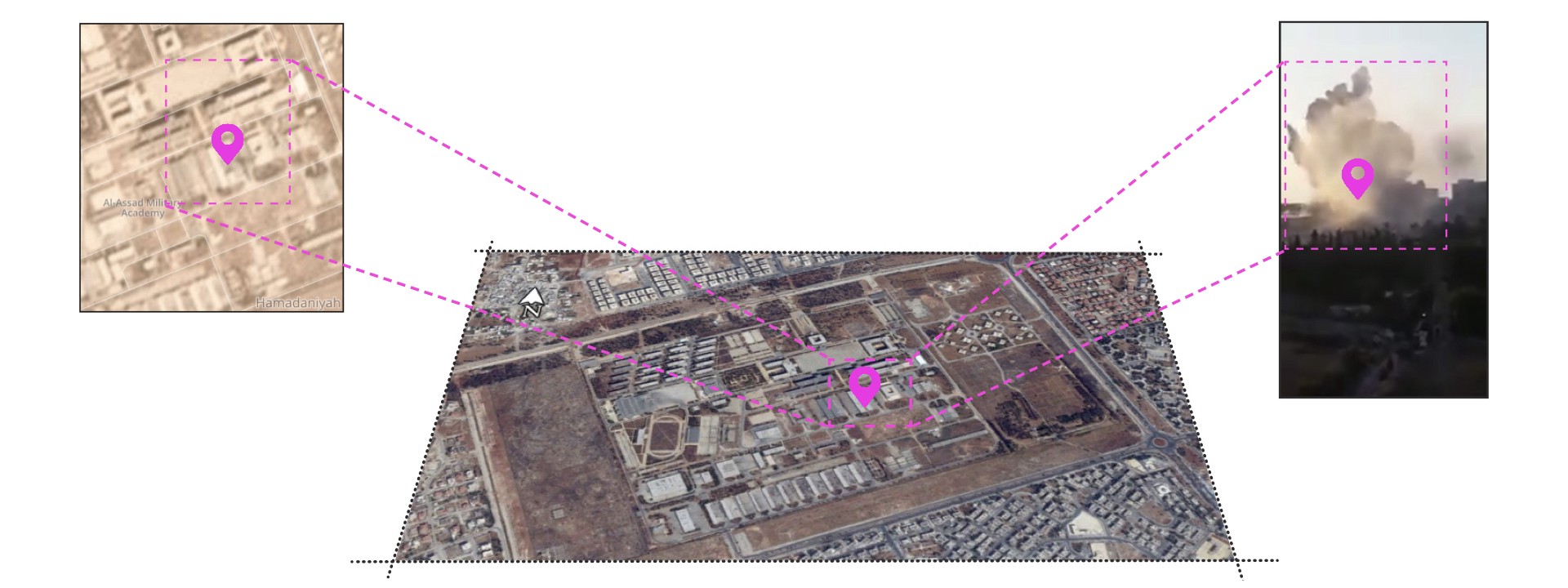#BreakingSyria: Explosions in Assad’s Military Academy
Open source evidence contests pro-Assad media claims about a rebel attack in Aleppo
#BreakingSyria: Explosions in Assad’s Military Academy

Open source evidence contests pro-Assad media claims about a rebel attack in Aleppo

A large explosion shook the neighborhood of Hamdaniyah in West Aleppo on September 21, 2018. On the same day, Pro-Assad media outlet SANA claimed that the explosion was the result of a terrorist attack with a rocket-propelled grenade (RPG).
A variety of photos and video footage taken by witnesses to the incident appeared on social media the same day, providing an opportunity to take a closer look into the incident. Footage from the scene, together with satellite imagery, suggested that the SANA conclusion was questionable.
The explosion took place at the Military Academy and was larger than a single shot from an RPG. If the reporting was accurate, the RPG shot was extremely accurate and hit something that caused a larger plume of smoke. Given the dense location and difficult access, it remains more likely that something else, like an accident at a munitions warehouse, occurred.
This case highlights a continued effort by pro-Assad media to portray local stories, regardless of facts, in a favorable way for the regime as an extension of the prolonged conflict in Syria.
Incident and Evidence
On September 21, Syrian Arab News Agency (SANA) released an article reporting on the explosion in the Hamdaniyah neighborhood in West Aleppo. According to the SANA reporter, rebels renewed their attacks on Allepo’s residential areas and were to blame for this attack. SANA’s reporting attributed the explosion to rebels firing a rocket-propelled grenade that fell in Hamdaniyah, near the residential area referred to as the 3,000 Apartments Project.
Simultaneously on social media, the first photos and video footage taken by the locals started to surface. Most of the visual information portrayed a large plume of smoke rising in a residential area. The size of the smoke plume suggested that an RPG alone could not have caused the damage, meaning the target or the munition would have to contain something more explosive.
One video captured the actual moment of the explosion and provided enough detail to geolocate the area.

The image included a large open area seen in the video with a small wooded area, which closely resembled the premises of Al-Assad Military Academy in Aleppo.

Based on the geolocation data in the video, it was possible to determine an approximate area of the explosion. The smoke plume rose from the area inside of the Military Academy.

Out of all the available imagery from the incident, only a few had definitive geolocation indicators. One of the photos showed a smoke plume rising from behind a network tower. A possible location of this photograph could be at the 3,000 Apartments Project area itself.

Satellite imagery was used to find the exact location of the explosion, by inspecting the territory of the Al-Assad Military Academy on the days of the reported explosion. One building had signs of damage in the period between September 21 and September 23.

The location of the damaged building also coincided with the direction found using the geolocation method (Geolocation #3). No other damage was observed in the area on this period of time.
While we can confirm the location of the damaged building on the premises of Al-Assad Military Academy, the purpose of the damaged building remains unclear. Some sources suggested that it was probably an ammunition warehouse that went off.
Conclusion
It is not currently known what caused the large explosion in West Aleppo.
Open source evidence suggested the explosion occurred in the Hamdaniyah neighborhood, rather than in the 3,000 Apartment Project area, as reported by the pro-Assad media outlet SANA. Furthermore, the fact that the destroyed building was located in the middle of Al-Assad Military Academy, decreases the possibility of a RPG attack. In order to shoot a rocket propelled grenade in a densely built up area, the perpetrator would have had to come close to the guarded building. The whole set of evidence suggested that the hypothesis of a exploded ammunition warehouse is more probable than the lone wolf rebel attack reported by SANA.
The questionable coverage highlights the extension of the conflict in Syria to the local information environment in areas that have exchanged command and control in the course of the seven year ordeal.
@DFRLab will continue to monitor SAA military developments and operations in Syria.
Follow along for more in-depth analysis from our #DigitalSherlocks.Security

